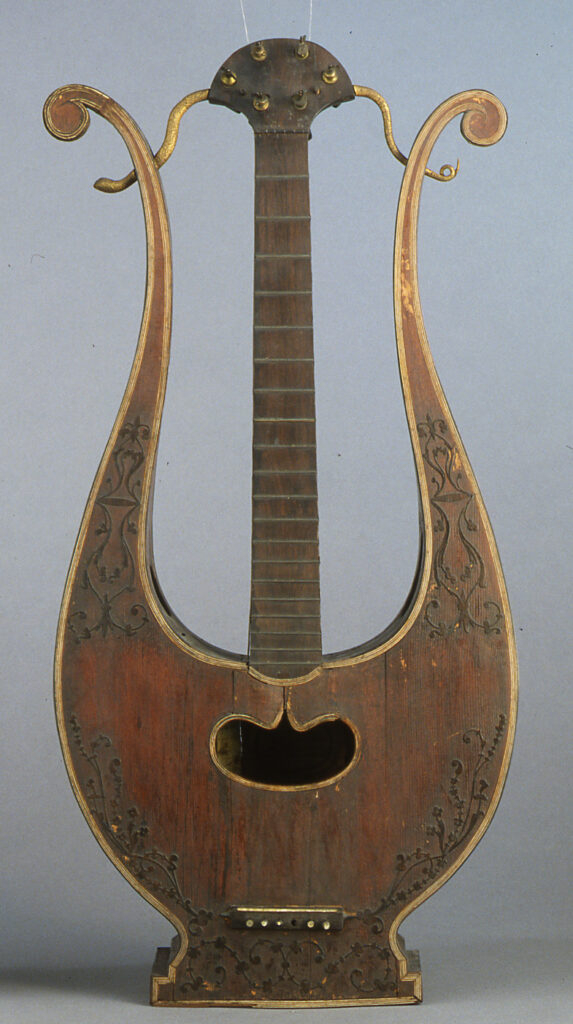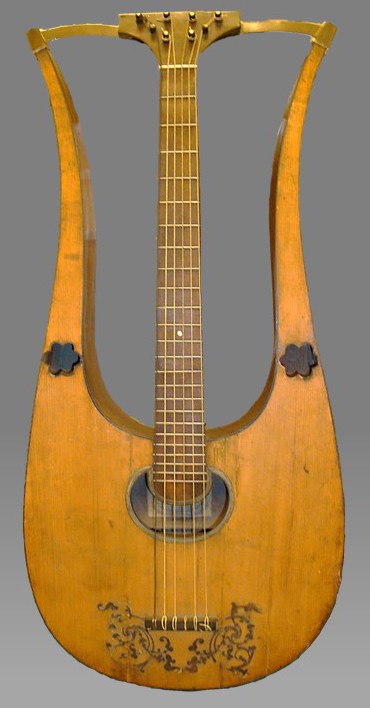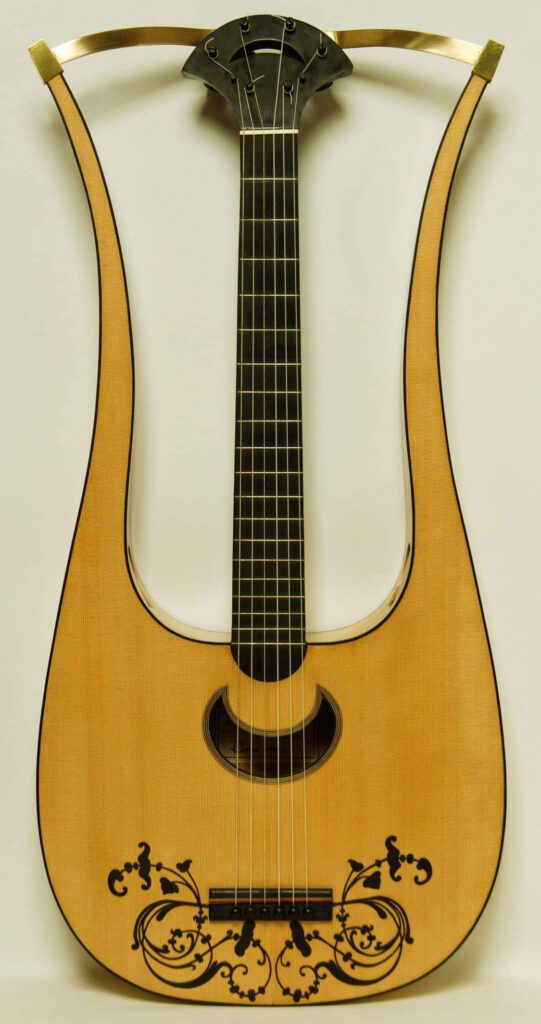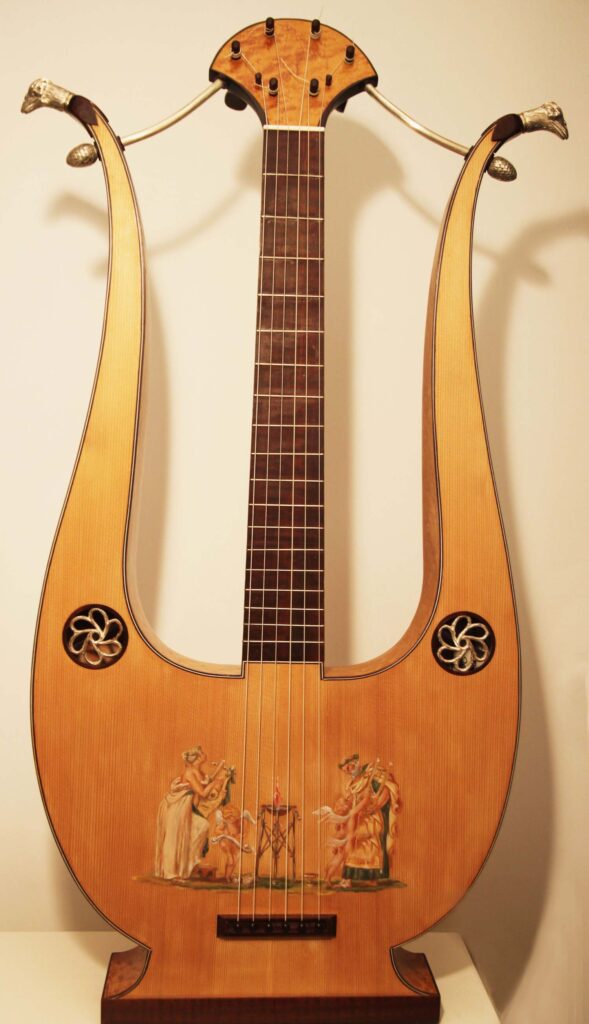Historical information about Lyre-Guitar
The lyre-guitar is an instrument endowed with great timbre, melodic and harmonic qualities but currently not much known. The most interesting specimens from an artistic and organological point of view are kept in museums and in some private collections.
The instruments that I have brought to light are unique copies made in Rome by the luthier Gerardo Parrinello. The first (2003) from an 1809 original by the Neapolitan luthier Gennaro Fabricatore and the second (2020) from an 1809 original by the French luthier Ignace Pleyel.
The history of this instrument is one of a kind and very fascinating. The lyre-guitar had a moment of great fame in Paris between the end of the eighteenth century and the first twenty years of the nineteenth century, a decisive moment for the evolution of the guitar.
The name ‘lyre-guitar’ is enough to suggest about its origins: the shape is that of the Greek lyre, with the addition of the guitar neck, while the ancient lyre only had strings stretched between the crosspiece and the bridge.
Around the mid-1700s, in France, an instrument that preceded the construction of the lyre-guitar made its appearance, commonly called French lyre. It had 7, 8 or 9 strings and a suspended neck. The decision to apply an interrupted handle towards the case was adopted to disrupt the shapes of the ancient lyre as little as possible. It was a difficult instrument to play given the extreme closeness between the lateral arms and the keyboard; it produced a weak sound and was intended only for accompaniment.
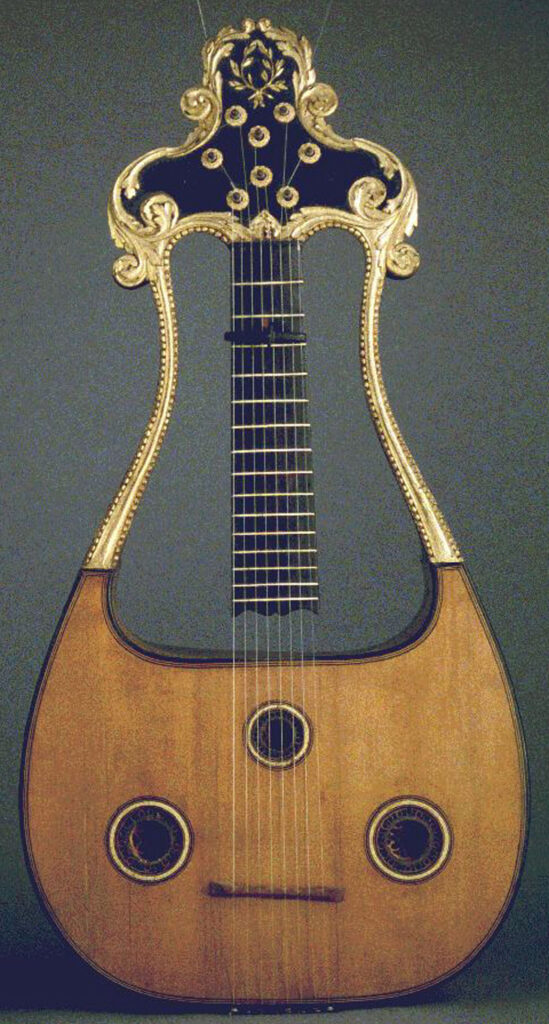
The lyre-guitar was born around the end of eighteenth century and the beginning of nineteenth century. It was more comfortable to play and with a louder sound.
The cult of the lyre-guitar grew from an infatuation with Greek antiquities among the noble classes of pre-revolutionary France.
The instrument was in fact adopted by the emerging middle class after the Revolution and during the Napoleonic era it spread throughout Europe.
«It captured the imagination of the Salon society in a short time and when fashions changed it disappeared just as quickly. The favor of the lyre-guitar was decreed and kept alive for several decades by those who could afford to buy it […]. The idea was to create an instrument that was graceful and provided a visual accessory to help fashionable ladies strike the graceful poses of the Greek ‘kithara’ players […]. Its cult was created by a style that derived its inspiration from classical art and literature. Its value was recognized when it was associated with the birth of the so-called ‘classical six-string guitar’. Its history is therefore intimately connected with that of the guitar» (Matanya Ophee, Soundboard, 1987).
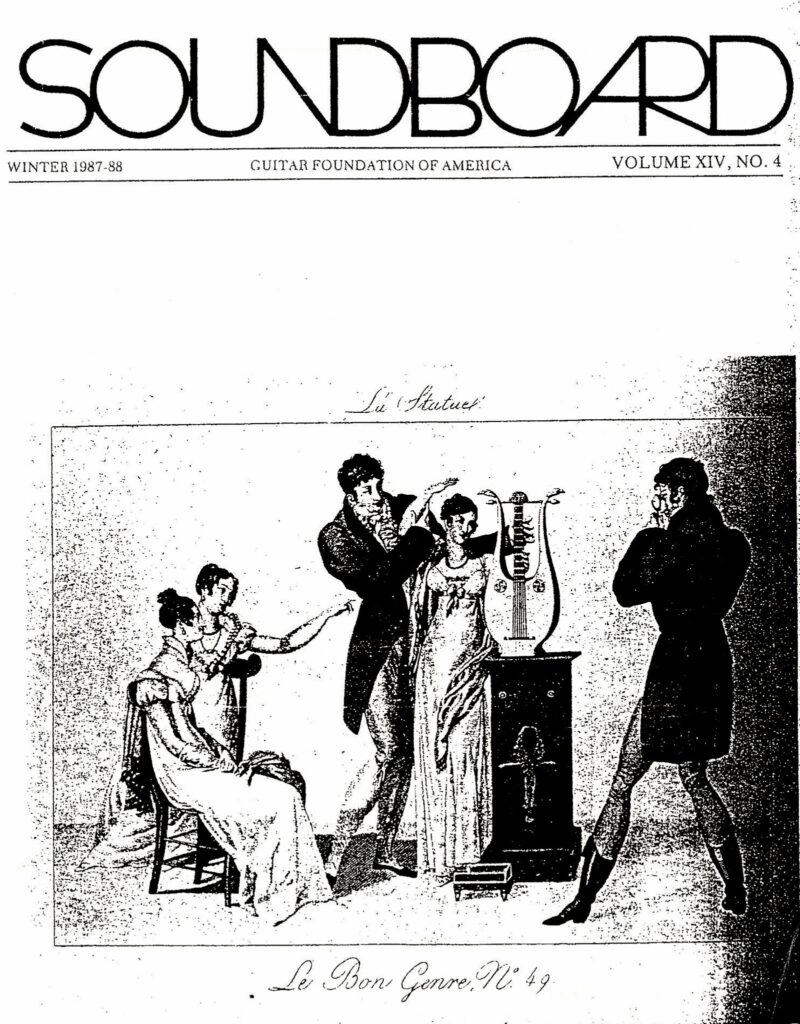
In the Neoclassic period this attraction for antiquity embraces art, architecture, painting and music. A real ‘classic style’ spread, the costumes and customs follow the models of the past, in particular from the Greco-Roman world; hence the guitar becomes a guitar-lyre, recalling very closely the forms of the ancient Greek lyre.
«The lyre-guitar then quickly imposes itself, it is a ‘dazzling, shining meteor’; it symbolized an instrument that served to entertain people of the Parisian Salon with that ancient mythological, pastoral and fabulous touch». (Mario Torta).
It was Pierre Charles Mareschal, a well-known French violin maker, who, in 1780, officially codified the instrument naming it ‘Anacreontic lyre’. The inspiration came from the poetry of Anacreonte, a Greek poet who lived between the sixth and fifth centuries B.C. He became a symbol of the whole poetic rediscovery movement, the Neoclassicism, which brought back the Greek mythological literature, the Arcadia, the golden age, the pastoral genre, so praised by the Greek lyricists (Anacreonte, Archilochus, Alcaeus, Sappho).
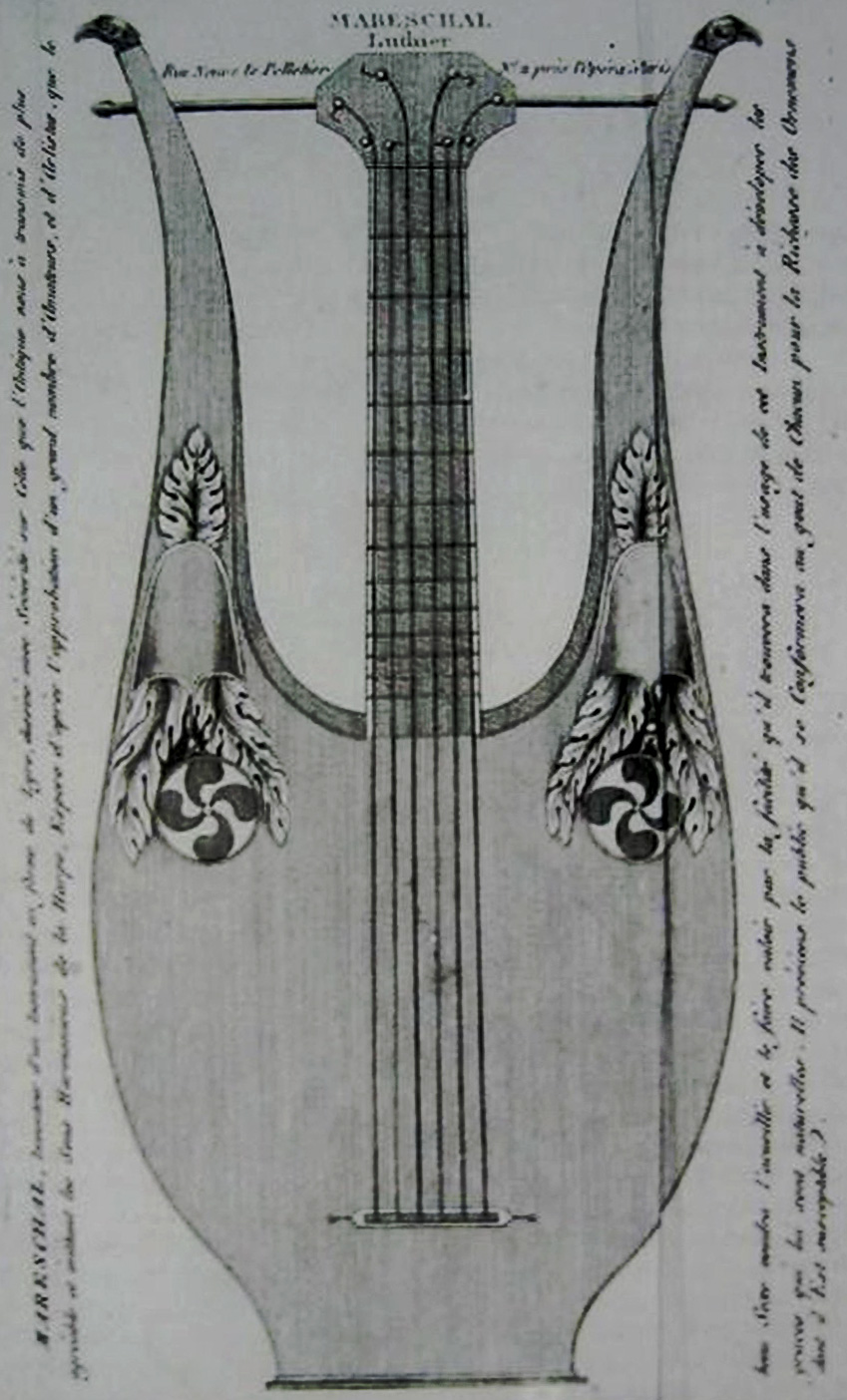
The lyre-guitar was so successful that it was almost considered a status symbol, an instrument that could not be missing in a noble family. Among the prominent figures, it was played by the empress Marie Antoinette of Austria, Madame de Stael, George Sand, the tenor Fabri-Garat and the singer Vogl, a friend of Schubert, who owned a model of the Parisian violin maker Michelot.
In the convivial atmosphere of the salons, the instrument is often associated with women. Given its graceful forms, the lyre-guitar was actually meant to be played mainly and preferably by women. In fact, there are many ancient paintings and important painters of the period that portray women dressed in the Greek style playing a lyre-guitar. An example is the painting by Jean Dominique Ingres portraying the family of Luciano Bonaparte, featuring a girl with a lyre-guitar.
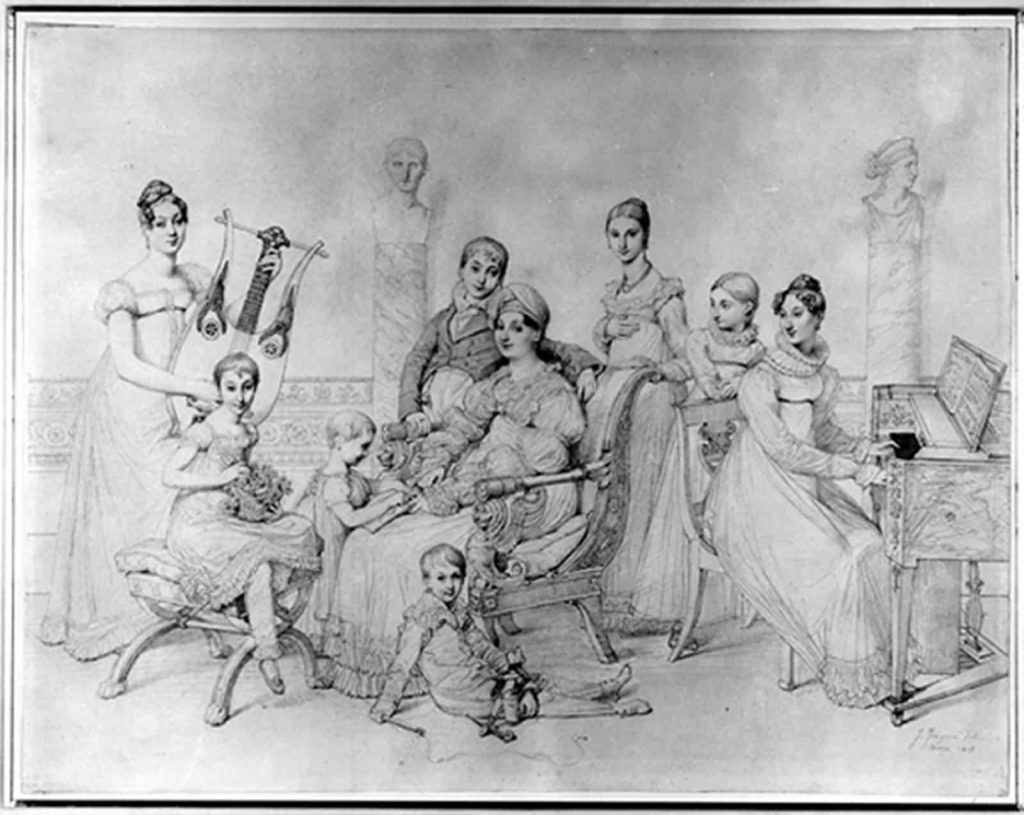
Among the many models of lyre-guitar, the most beautiful and suitable to be played both in the solo and chamber repertoire are those that have 19 or 20 keys. They differ from the smaller and undecorated 14-key ones, mainly intended for singing accompaniment and with less sound capacity given the small size.
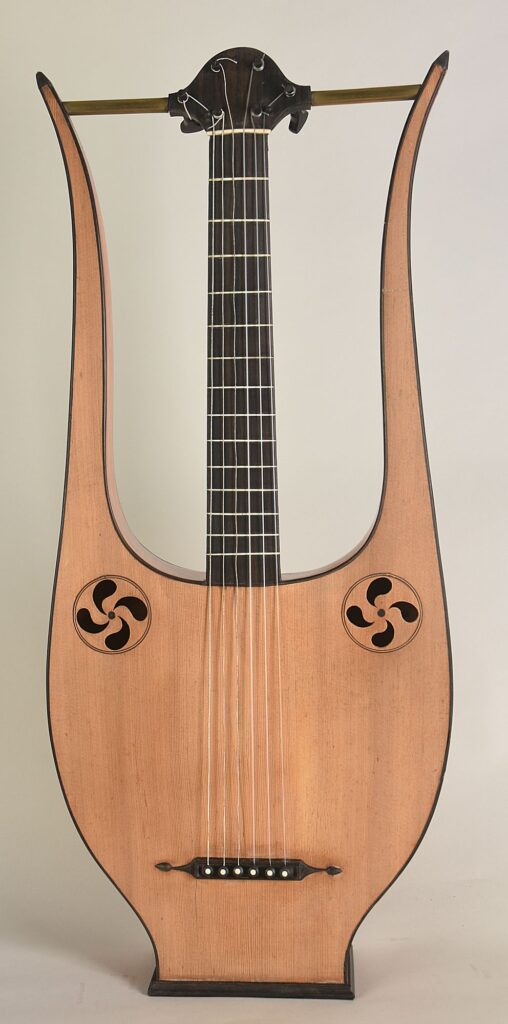
Returning then to the 19/20 fret model, from an acoustic point of view, due to the considerable size of the sound box, it has a full-bodied sound, undoubtedly different from that of the contemporary romantic guitar.
Even the keyboard differs a lot from the guitar: the length is the same, the keys also, but while in the guitar the joint between the handle and the case corresponds to the 12th fret, in the lyre-guitar it corresponds to the 19th key. For this reason there is greater possibility to exploit, with more ease and manageability, the whole keyboard up to the last keys, since there is no case that prevents the rapid movement of the left hand beyond the 12th fret. On the other hand, however, the left hand is not completely free as on the guitar because of the presence, in the lyre, of the arm below the keyboard; it is therefore advisable to support the movement of the instrument arm with one ‘s own movements. Obviously, a smaller hand, like that of a ‘girl’ has a greater ability to move.
There were various types of lyre-guitar with the most disparate shapes and often remarkably decorated with neoclassical decorations: the arms could be curved like the lyre or take, for example, the appearance of ancient imperial-style columns ending with opposing eagle heads or with highly decorated capitals. The palette could take the form of imperial crowns, family crests, Greco-Roman style friezes. The case was often decorated in every possible way: marquetry, figures representing mythological scenes, floral designs… Moreover, most of the instruments had, in the lower part, a base, more or less decorated as well, which served to elegantly rest the instrument on the ground.
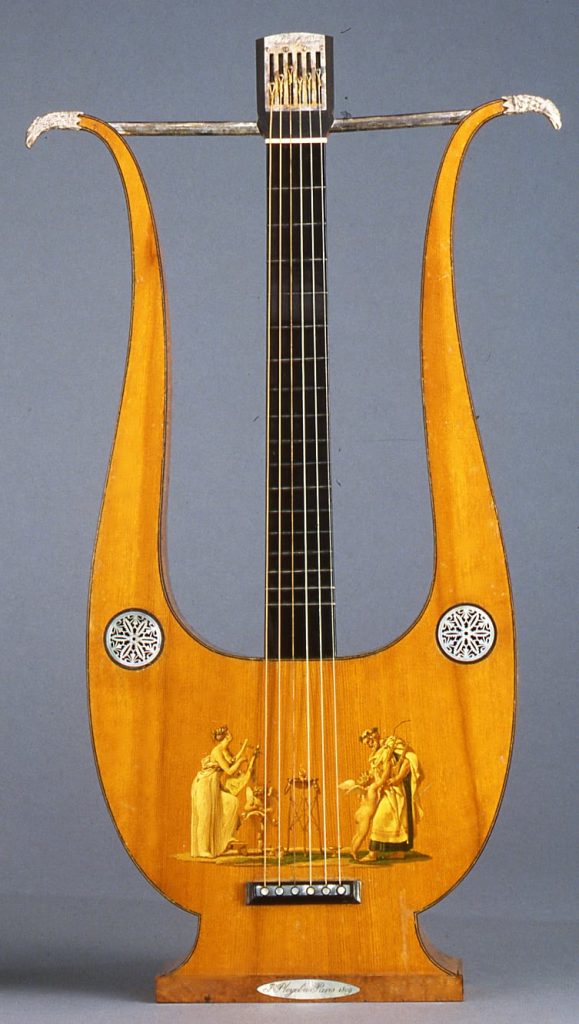
Being able to obtain a remarkable sonority, the lyre-guitar is suitable not only for performing excellently in the solo repertoire but also for playing in various chamber ensembles, accompanying singing, in duo with violin (or flute), in trio with singing and the violin (or the flute), up to concertizing with a chamber orchestra.
The sophisticated and original repertoire includes music by some of the most authoritative 19th century guitar composers. Writers for lyre-guitar: Ferinando Carulli, Matteo Carcassi, Mauro Giuliani, Francesco Molino, Fernando Sor, Salvador Castro de Gistau, Pierre Jean Porro, Etienne Jean Battista Pastou, Antoine Marcel Lemoine, Alois Franz Simón José Molitor…
«The expressive horizon of this music is strongly related to the convivial, amiable and playful character of the music of the late eighteenth century. In fact, in the texts there is always a reference to stereotyped love situations or pastoral representations and above all there is a feeling inclined to tenderness and emotion typical of the gallant style of the mid-eighteenth century». (Mario Torta)
Around 1815 the destination for the instrument (‘guitare ou lyre’) on the title pages of the methods began to disappear. The ‘lyre-guitar’ undergoes a decline or, better to say, ‘goes out of fashion’ around the middle of the century, to give way again to the guitar. It has a short and well-defined life: about 40-50 years between the end of the eighteenth century and the first half of the nineteenth century. Yet, though brief, its story was significant.
MY INSTRUMENTS:
The Fabricatore model:
it has a wide spruce soundboard and flamed maple back and sides. The fingerboard is in ebony with 19 fixed metal keys and it has a diapason of 63 cm; the ends of the arms are connected to each other by a brass crosspiece which has a purely decorative function, to better imitate the features of the original lyre. The central hole and the two lateral ones obtained in the arms have the shape of a half-moon. The blade has the same decorative design, with a half-moon-shaped cavity.
The Pleyel model:
The copy has a spruce soundboard, back and sides in eyed maple and a serpentine fingerboard (‘Piratinera Guianensis’) with a diapason of 61 cm.
Some changes have been made from the original. The fingerboard has 18 frets and the soundboard overlaps the neck by 15 mm, remaining at the level of the fingerboard, while the original has 17 frets and the fingerboard ends at the neck/body junction.
The two side holes have a floral-shaped silver wood inlay with a different design from the original. The headstock, in eyed maple and rosewood, has the shape of a rounded crescent with tuning pegs while the original has a rectangular shape with a screw string tension system.
The cross bars end with two small decorative pine cones, both in silver, which are not present in the original.
On the base, the original bears a plate with the name of the luthier and the date of construction which was not reproduced in the copy, as well as the engraving ‘Fabry-Garat’ on the silver plate applied to the headstock. The original is decorated with paintings of classical inspiration, created by the painter Pierre Guérin, which include: on the left, a woman playing the lyre next to a cherub who writes on a sheet with a feathered pen; to the right, a man with a laurel wreath playing a ‘column’ lyre-guitar together with another cherub who extends his hand to pluck the strings. The instrument was commissioned by Mr. M. Somma Riva who paid homage to the tenor Fabry-Garat, whose name is engraved on the headstock. The Neoclassical paintings have been meticulously reproduced.
Finally, I mention some instruments (located between the end of the 19th century and the beginning of the 20th century) which today are often confused or associated with the lyre-guitar, such as the lyre-guitar by Luigi Mozzani, the mandolira, the arpolira, the harp, the mezzalira or lyre with one wing etc, which have nothing to do, both musically and organologically, with the lyre-guitar.
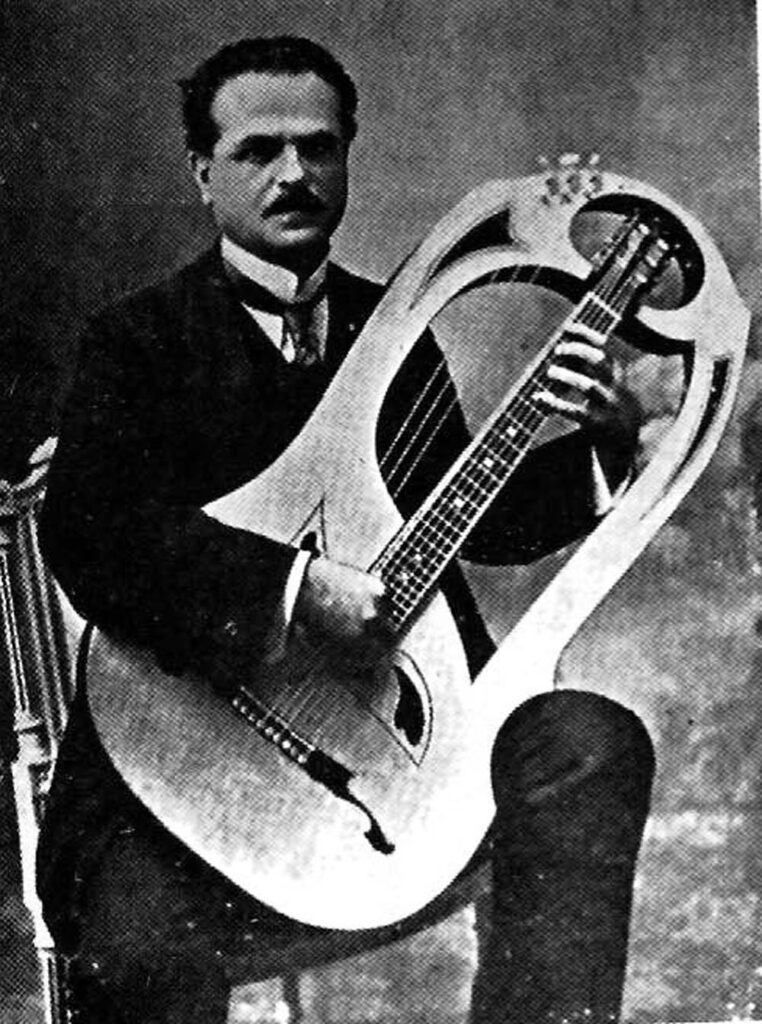
The musicological value of the project that I am presenting and on which I have been working since 2002 is given by its very originality: for the first time an instrument and a repertoire of considerable historical-artistic importance have been rediscovered and re-evaluated which until now has remained unknown to the public and often to the same musicians/guitarists who have been gradually approaching the study of this instrument since around 2020.
(last update: March 2023)

